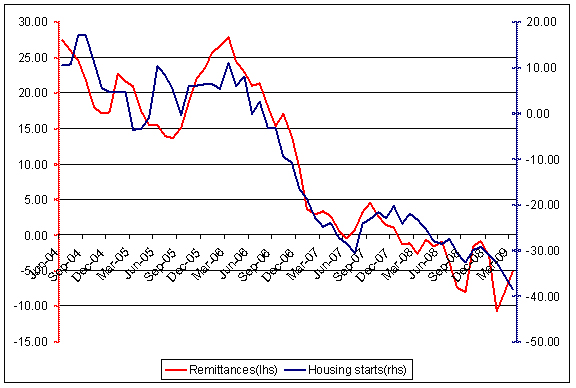Recent evidence collected by the Dallas Fed's Pia Orrenius suggests that apprehensions of undocumented workers attempting to cross the U.S.–Mexican border are a good predictor of the overall American job market. Simply put, if one wanted to predict job market conditions in July of a given year, one should examine immigrant apprehensions in January. Orrenius finds that more immigrants attempt to cross the border from Mexico (and more of them are caught doing so) when immigrants believe the U.S. economy would offer more jobs in the near future.
One area of the economy that relied heavily on immigrant labor was housing. The following chart plots monthly U.S. housing starts (lagged five months) and remittances to Mexico. (I use year-over-year growth rates and smooth the noise from very short-run fluctuations by using a three-month moving average in my analysis.) I use remittances as a proxy for migrant Mexican labor.
Figure: Housing Starts and Remittances to Mexico

Note: Remittances in U.S. dollars. Housing starts indicate new, privately owned housing units.
Source: Bank of Mexico (remittances), Haver Analytics (housing starts)
The correlation between the two data series is strikingly high. For instance, the plunge in housing starts that began in early 2006 was followed by a sizable drop in remittances growth five months later. Of course, the results are not unexpected as the construction industry heavily employs immigrant labor.
Also, it is well known that immigrants send remittances to their country of origin on a regular basis. Some estimates indicate that the remittances sent by immigrants from developing economies back home reached $305 billion in 2008. (As an aside, keep in mind that because of unrecorded immigration flows through formal and informal channels, the actual numbers are likely to be significantly larger.) Remittances are particularly important for smaller Latin American countries. In 2007, for instance, recorded remittances represented more than 10 percent of the gross domestic product in several Latin American countries, including Honduras (25 percent), Guyana (24 percent), El Salvador (16 percent), and the Dominican Republic (13 percent), among others.
What is especially remarkable from a macroeconomic perspective is the volatility of these capital flows. During the housing boom, remittances to Mexico were growing at 20–25 percent annual rates (see the chart). With the onset of the global economic crisis, however, remittances have been declining, falling by almost 10 percent early this year. For smaller emerging economies, the volatility in remittance flows becomes a significant extra source of instability.
Migrant workers enter the country in response to upturns in domestic labor demand, and that upturn results in higher remittances both because of the increased number of immigrants but also because the existing stock of immigrant workers is earning more. Conversely, a downturn in labor demand should be reflected in lower remittance flows because of out-migration as workers return home and because of lower earnings among the remaining stock of migrants. But what happens when some of those workers have entered the country illegally?
In a study published in 1997, Belinda Reyes found that about two-thirds of the undocumented immigrants returned to Mexico within three years upon arrival. In a recent paper I wrote with Andrei Zlate, we explore the implications of changes to enforcement policies for the U.S./Mexican border on undocumented labor and remittances. We find that increased border enforcement during the last decade has broken the typical pattern of flows of undocumented workers. Basically, while increased enforcement makes it harder/more expensive to enter the country, it also reduces the incentive for those already in the country to leave. Why? Because of the high cost/risk associated with reentering the United States in the future.
In a recent paper, Carolina Rodriguez-Zamora adds support to our claims. She finds that as the U.S. Department of Homeland Security increases the amount of resources spent policing the border undocumented immigrants tend to stay longer.
Increased enforcement protects the existing stock of undocumented immigrants from additional competition, and this development can put upward pressure on wages when U.S. labor demand is high. When labor demand is low, rather than returning home, these individuals could remain in local labor markets, placing additional downward pressure on wages.
By Federico Mandelman, research economist and assistant policy adviser at the Atlanta Fed


